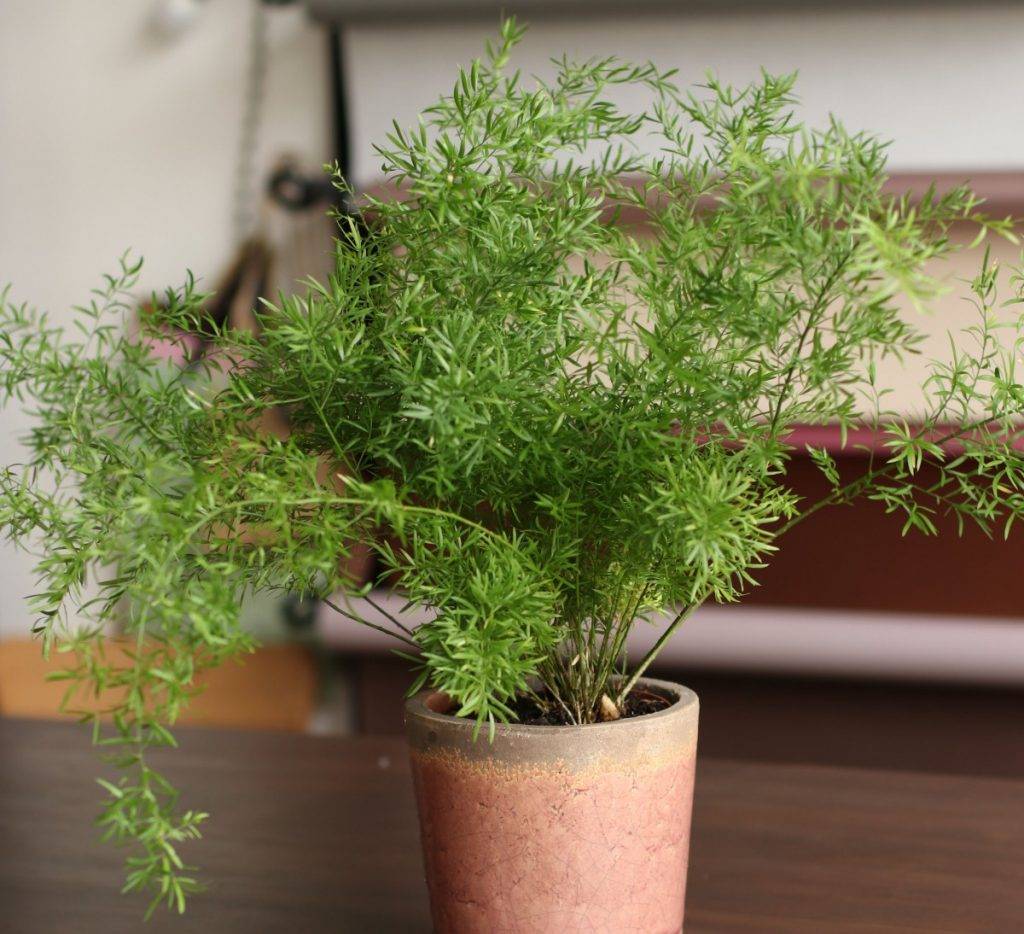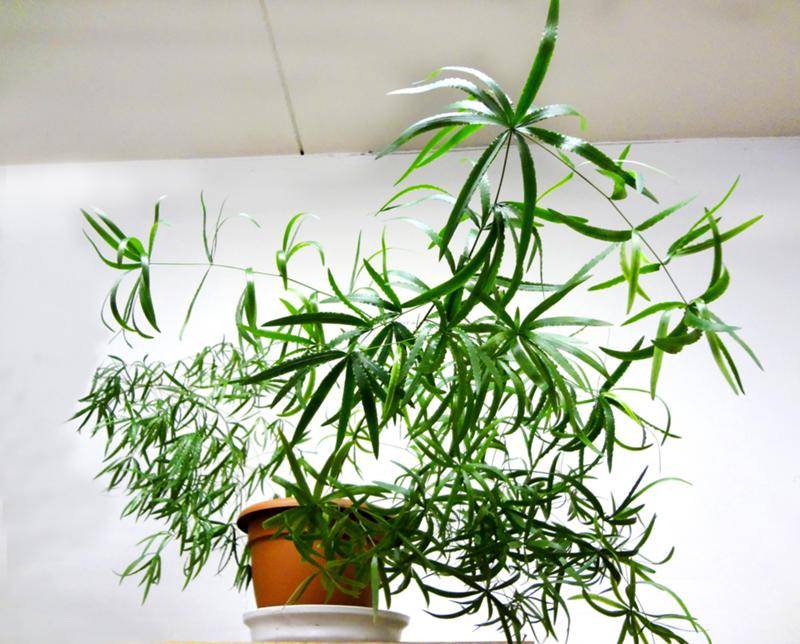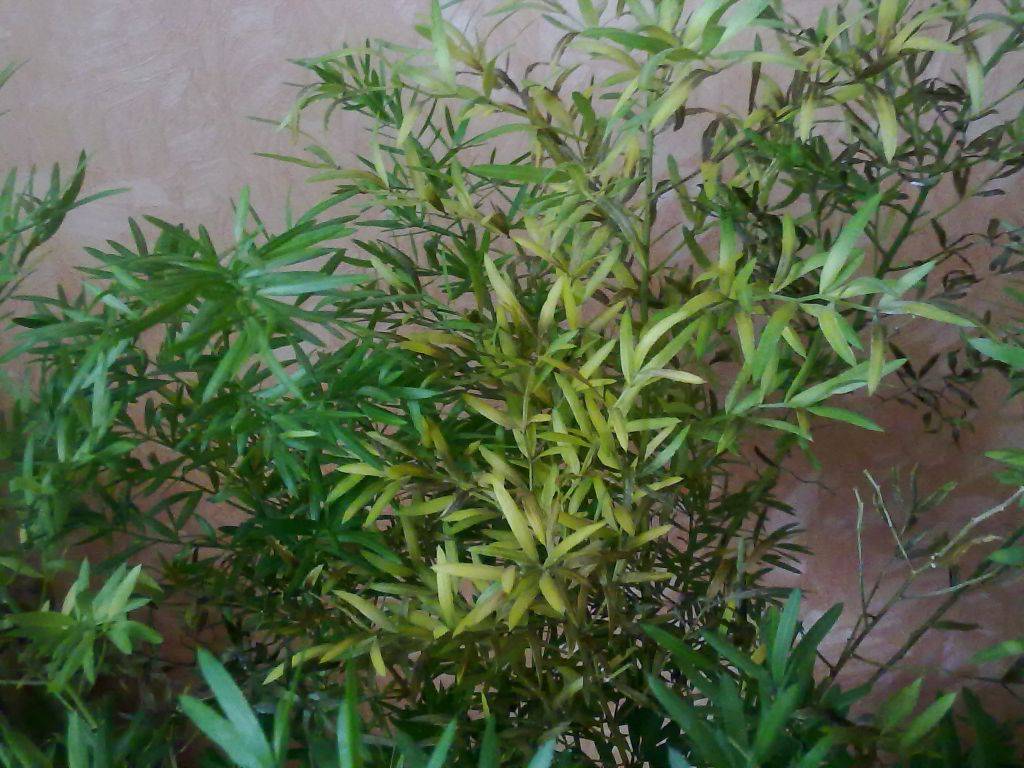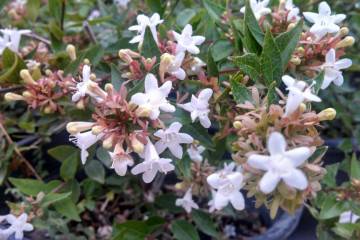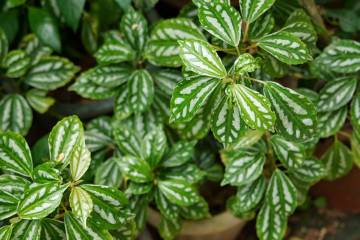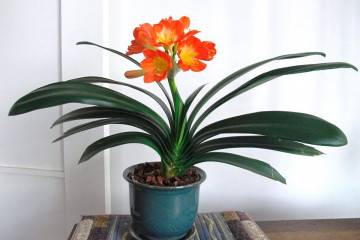Asparagus sickle - home care
Content:
Asparagus Falcatus (sickle) is considered one of the best and most sought-after ornamental plants. Its spreading vines create a cozy atmosphere both in the house and on the balcony.
What does the sickle asparagus look like, which family does it belong to?
Asparagus (asparagus) crescent belongs to the Asparagus family. This is an unusual plant that today has more than 300 varieties. Asparagus is presented in the form of a spreading shrub or liana.
Common varieties
The following common varieties of the asparagus plant are distinguished:
- Common asparagus. Grows in Africa and North America. Reaches 150 cm in length. Differs in red fruits that bloom at the end of August.
- Asparagus is asparagus. It grows mainly in South Africa. Reaches 160 cm in height. It has small fruits in the form of berries with an orange aroma.
- Asparagus Ethiopian. Located in South African countries, its dimensions reach 150 cm in height. Differs in fragrant beige and white inflorescences and red berries.
Healing properties
Asparagus shoots are used to treat people with diabetes mellitus and vitamin deficiency. Often, the plant is used to reduce swelling and inflammatory processes in the body.
History of appearance
For the first time, the sickle asparagus or Falcatus appeared more than 2000 years ago. In ancient Egypt, it was used as a medicinal plant that helped to get rid of many diseases. In Greece, festive wreaths were woven from its branches. In Russia, the plant became popular only in the 18th century.
Features of caring for a plant at home
For asparagus to grow healthy and strong, you need to provide it with the right conditions for development.
Temperature
Asparagus sickle does not tolerate high and low temperatures. It is necessary to contain it at rates from 20 to 25 degrees Celsius. High temperatures can cause stem rot.
Lighting
Asparagus crescent requires constant lighting for productive growth. It needs to be grown in good light. In this case, direct sunlight should not fall on the plant. Gardeners recommend displaying crops on the east or west side of the home.
Watering
In summer and spring, asparagus is watered abundantly (up to 2 times a week). In winter and autumn, watering is done less often. But the substrate should not be allowed to dry out. You need to focus on 1 watering per week. If the liquid stagnates in the pan, it must be removed to prevent rotting of the root system.
Spraying
Seasonal spraying is necessary to prevent insects from appearing.They are performed in early spring and autumn.
Humidity
Asparagus crescent loves moderate humidity. Therefore, it is not recommended to allow the soil to dry out. The same rule applies to soil oversaturation with water. The plant is kept in a well-ventilated area with moderate humidity. It is best to place the flower in rooms with a lot of windows.
Priming
The plant culture loves carefully prepared soil. Therefore, before planting, the soil is mixed with humus, sand and mineral components.
Top dressing
In spring and summer, gardeners recommend fertilizing asparagus every week or two with organic fertilizing. In autumn and winter, fertilizers are applied 1-2 times a month. For this, nitrogen and potassium solutions are used. In the cold season, asparagus does not need abundant feeding.
Features of winter care during the rest period
In winter, it is necessary to reduce the frequency of treatment procedures. This applies to watering, fertilization and preventive spraying. Asparagus is watered once every 2 weeks, fertilized once a month. You can sprinkle the leaves 1 time before the onset of cold weather.
When and how it blooms
Asparagus is distinguished by beautiful inflorescences, which are presented in the form of buds scattered in a chaotic manner.
Flower shape
The asparagus culture gives rounded flowers of a white or cream shade with a rich odor. After the inflorescences die off, small red berries appear on the branches of the shrub.
Flowering period
The appearance of flowers and berries occurs in the summer and hot seasons (late July and early August).
Changes in care during flowering
When the asparagus begins to bloom, you need to pay special attention to the soil in which it grows. This will help extend the growing season and nourish the plant culture with useful components. In late spring and early summer, you need to water the bushes more often, but avoid water stagnation in the pan.
Pruning
Pruning asparagus is necessary for more productive growth of its stalks, as well as for the development of young shoots. The optimal period for the procedure is March or April. Cut off 20-25 cm from old and dried branches, after which the crown is treated with prophylactic mixtures. Periodic pruning is necessary to form a beautiful and branched vine.
How the sickle asparagus reproduces
Reproduction of crescent asparagus occurs in several ways: cuttings, germination of seeds and air layers.
Germinating seeds
To do this, soak the asparagus seeds in an organic or mineral solution for several days. Alternatively, use rainwater or melted snow. After that, the seeds are planted in the soil and watered regularly.
After the first sprouts appear, the asparagus is transplanted into pots. They are regularly replaced as they grow.
Rooting cuttings
This method is used mainly in early spring. A shoot up to 20 cm long is cut from an old branch, sprayed and placed in a vessel with clean water. Alternatively, a mixture of sand and peat is used. After that, they wait until the stems take root and plant them in a spacious pot. In this case, it is worth monitoring the temperature regime in the room. Allowable rates vary at 22 degrees Celsius. The root system of cuttings is formed in 1.5-2 months.
Air layering
To propagate the plant, a deep cut is made on its strong branch, a match or a thin stick is inserted into it, the structure is covered with sphagnum and the appearance of root shoots is expected. This type of breeding is rarely used.
Other options
Bush division is also used to propagate asparagus. To do this, in the spring, the shrub is divided into 2 equal parts, transplanted into different pots with pre-fed soil, and the inflorescences are looked after according to the standard scheme.
Transfer
Asparagus is characterized by good and productive growth, which indicates the need for regular transplants. During the procedure, it is recommended to remove all old and dried branches. This will ensure fast growth for young shoots. Each time the asparagus grows to its maximum size, it is transplanted into a large bowl.
Possible growing problems and diseases
If you do not follow all the recommended care rules, there is a risk of encountering some problems.
Drops buds and leaves
If the leaves of homemade asparagus are crumbling, this may indicate a lack of nutrients. A similar phenomenon is noticed in the absence of timely fertilizing with mineral and organic fertilizers.
Leaves turn pale
If the leaves began to turn pale and yellow, it is worth revising the watering regime for the asparagus crop. With excessive moisture, the shade of the foliage often changes. The same happens with dehydration and lack of water.
The tips of the leaves dry
Dried ends can indicate dehydration and vitamin deficiencies. To remedy the situation, it is necessary to transfer the flower to the western or eastern part of the house, as well as water it. Dryness can also appear due to lack of light.
The lower leaves fall
Falling leaves signals the appearance of pathologies or pests. To eliminate the problem, you need to spray with fungicides.
Pests
Insects interfere with the growth of asparagus during spring or summer. To prevent them, preventive spraying is carried out in January-February.
Other reasons
On homemade asparagus, yellowness, putrid areas may appear. All this speaks of improper crop care and a lack of vitamin components.
Signs and superstitions
According to ancient legends, asparagus is a cleansing plant that can relieve people of melancholy and depressive mood.
Asparagus crescent asparagus falcatus is a beautiful plant that is used for interior decoration. Asparagus Falkatus is unpretentious in care and does not require special growing conditions. In addition to its good appearance, asparagus helps to heal many diseases of the human body.
